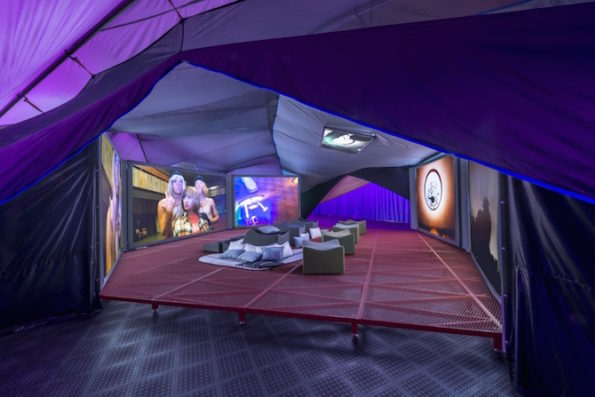Search
To search for an exact match, type the word or phrase you want in quotation marks.
A*DESK has been offering since 2002 contents about criticism and contemporary art. A*DESK has become consolidated thanks to all those who have believed in the project, all those who have followed us, debating, participating and collaborating. Many people have collaborated with A*DESK, and continue to do so. Their efforts, knowledge and belief in the project are what make it grow internationally. At A*DESK we have also generated work for over one hundred professionals in culture, from small collaborations with reviews and classes, to more prolonged and intense collaborations.
At A*DESK we believe in the need for free and universal access to culture and knowledge. We want to carry on being independent, remaining open to more ideas and opinions. If you believe in A*DESK, we need your backing to be able to continue. You can now participate in the project by supporting it. You can choose how much you want to contribute to the project.
You can decide how much you want to bring to the project.

To enter into Regen Projects opens up your pupils: from the intense midday sun of the Santa Monica Boulevard to the dark bowels of a black box occupied by sparkling arthropod sculptures. The creatures incorporate functions Trecartin and Fitch have observed elsewhere. In the first room you circle them and afterwards on entering into three other spaces you are the one to change roles. In each of them, an installation configured out of a variety of screens and camping equipment. Ikea cushions, pieces of cloth, hammocks, chairs. Rose, blue, black, gold, silver. You lie down and look up, fixing your eyes on the screens. They hypnotise you. Meanwhile accelerated voices, characteristic of the production of these two artists, screeched out by heavily made up artistes, drawn from online profiles, wigs out of place and dripping sweaty make-up. You want to return to an upright position because unwittingly you find you have relinquished your body to the piece and it’s increasingly hard to feel human again. The all-enveloping ambiances of Trecartin reach an extreme in the largest of the gallery spaces, where a large tent envelops the architecture from the inside, allowing its tensors to redefine the space as a sort of plastic cocoon[This exhibition could be seen at [Regen Projects LA. from October to November 2014]]. One wants to settle in, as if commanded to by the work, but it ends up being hard to find a nook in the rigidity of the design. On one of the screens a drone flying GoPro chasing parachutists indicates to us that Ryan and Lizzie also have other registers. The artist is versatile. In the rest, the usual, Red bull accelerated girls in drag with nipples blazing.
In relation to technology the artist say he prefers tools that aren’t versatile. Nostalgic, in an interview with Hans Ulrich Obrist, Ryan remembers the transformation he experienced having discovered imovie at university. Afterwards, he said, he had access to the possibilities that after effects opened up, but that this software, despite offering a greater degree of control over the product, slowed up the editing process. Trecartin’s wager on distancing himself from the causality of film once again becomes obvious in his defence of the script as a detonating node of infinite possibilities, rather than as the narrative articulation of his videos. The filming is at night. Spaces for panic, for spontaneity, for the toxic. Instead of personifications, his characters are possibilities. Behaviours observed in other objects. Adjectivations. Preachings applied to bodies and stage-settings tools in the multiversal fishing net orchestrated by Ryan y Lizzie. With regard to the contents of his videos, Trecartin prefers not to judge. He enjoys exploring what happens on the film sets. Positive and negative judgements coexist in his films, he says.
Trecartin and Fitch have collaborated since the were students at Rhode Island School of Design. Since then their production studio has passed through New York and New Orleans, before setting up in Los Angeles. They have had important exhibitions in MoMA PS1, Istanbul Modern, Musée d’Art Moderne de la Ville de Paris and The Power Plant de Toronto. Their installation Priority Innfield could be seen at the Venice Biennale of 2013, commented on at the time by Sonia F. Pan for A*DESK . The technologies of entertainment are their conduit and background. The expanded films of Fitch and Trecartin exist by identifying with a Los Angeles, where life is lived histrionically, toxically, in panic, nipples ablaze. These are the shots, the bodies, the rooms and the colours. How to apply the attitude of the city to the format of a film? Mobile phones and repeated short phrases discipline the bodies in their videos, feminine identities taken to sarcastic extremes, transvestite unannounced bodies. Characters who change bodies, as if mantles, in a disparate collective representation of the passing into adulthood. The endeavour. Trecartin says he doesn’t want to position himself.
The pieces without a doubt show a profound commitment to the development of a current formalism. [Some can be seen online, such as [Center Jenny, Any Ever (Trailer) or A Family Finds Entertainment]]. They show how technologies determine the possible images of the world and they historicise every endeavour to represent it. But the alleged lack of position Trecartin insists is never there. Reclaiming the use of popular technologies such as imovie, enjoying the submission to Red bull to live in panic, defending how in this way he pursues the elimination of hierarchies, Trecartin seeks to place himself symbolically within any millennium, but he isn’t. Critics have presented him since his beginnings as a prodigal child who limits himself to using what he has within reach as we can read in the report dedicated to him in the last March 2014 edition of the New Yorker. This wager on a biographical model for the analysis and contextualisation of an artistic career always situates the creator on the pedestal of whoever can intuit the historic moment. Some of us resist believing in this way of writing history, as it only reproduces the blindness of the one who narrates it. We question the relation between this type of criticism and Trecartin’s product. The production of an artist and its access to the elite of the art system is never a symptom of the organicity of the figure of the genius. It is always due to relations between people and technologies computed in the generation of objects. Fitch and Trecartin pursue the reconciliation between the habitus of a class to which they don’t pertain and their place in the art market. It’s great to seek to renew contemporary video incorporating the popular use of cheaper technologies, but don’t have the cheek to say you don’t perceive the difference between them and you.

Paloma Checa-Gismero is Assistant Professor at San Diego State University and Candidate to Ph.D. in Art History, Criticism and Theory at the University of California San Diego. A historian of universal and Latin American contemporary art, she studies the encounters between local aesthetics and global standards. Recent academic publications include ‘Realism in the Work of Maria Thereza Alves’, Afterall, autumn/winter 2017, and ‘Global Contemporary Art Tourism: Engaging with Cuban Authenticity Through the Bienal de La Habana’, in Tourism Planning & Development, vol. 15, 3, 2017. Since 2014 Paloma is a member of the editorial collective of FIELD journal.
"A desk is a dangerous place from which to watch the world" (John Le Carré)